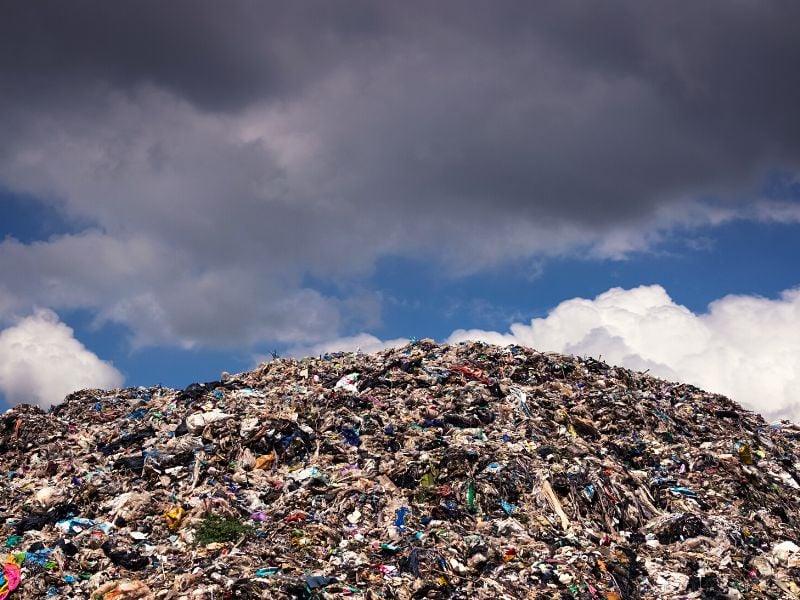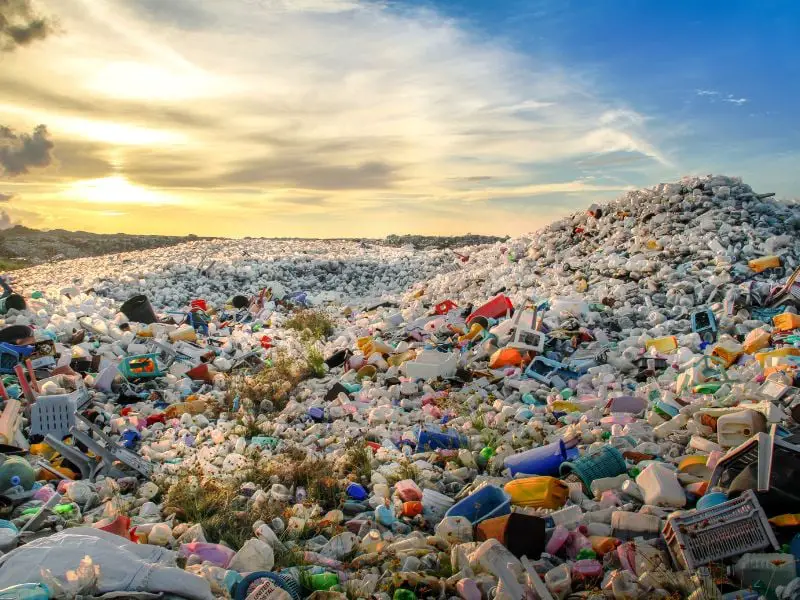Wherever there are people, there is always garbage. As the human population increases and becomes richer and more wasteful, the size and scale of rubbish heaps continue to grow, sometimes reaching unfathomable proportions and dimensions. Some are effective, contemporary, and cutting-edge, while others are unhygienic and pose significant threats to human and environmental health.
In the 21st century, human waste has become a critical environmental issue. According to the Environmental Protection Agency (EPA), globally, approximately 2.01 billion tons of solid waste are generated yearly.
In this article, we have compiled a list of some of the largest landfills, trash dumps, and waste disposal facilities around the globe, measured in terms of the total area covered by them.

“Landfills are testaments to our ability to create problems and neglect them.”
– Mark Caine
10 Largest Landfills In The World
1. (2,200 Acres) Apex Regional Landfill
The Apex Regional Landfill is the world’s largest landfill and will likely remain the largest one for some time. The dump is located 200 miles from Raleigh, North Carolina, and currently holds the Guinness World Record for being the largest landfill in the world. The landfill has been operational since 1993 and accepts residential and commercial trash.
The site takes in over 8,000 tons of trash daily and is expected to increase its capacity by over 20 years. The Apex dump can hold 50 million tons of trash and has a lifetime estimated to be anywhere from 200 to 250 years. This dump facility receives close to 300 tons of waste every single hour.
Green measures: The gas-to-energy operation at the Apex landfill creates 11 megawatts of renewable electricity, enough to power 6,000 households.
2. (927 Acres) Bordo Poniente Landfill, Mexico City, Mexico
The second largest landfill in the world is the Bordo Poniente landfill in Mexico City, Mexico. It occupies approximately 927 acres and is 800 feet tall at its highest point. The operator of the landfill is Grupo Mexico, and it is the largest landfill operator in Mexico.
The Bordo Poniente landfill is famously known for being one of the world’s most polluted and contaminated landfills. The dump has been temporarily closed several times due to emissions of harmful gases and odorous liquids, which have contaminated nearby communities and severely degraded the surrounding environment.
Green measures: At that time, a power company known as BMLMX had just secured a deal with the Government of Mexico to use the methane from the landfill site to create electric power that would be able to light the streets of Mexico for the next 25 years.

“A landfill is a monument to the throwaway society.”
– Edward Humes
3. (892 Acres) Laogang, Shanghai, China
The Laogang dumpsite in Shanghai, China, is one of the largest landfills in the world. It has an 892-acre surface area and a capacity of more than 30 million tons of trash. It is located near the Yangtze River estuary and borders Guandong Province and Jiangsu Province.
Initially constructed in 1988, the Laogang dumpsite closed in 1998 due to health concerns. However, after a massive cleanup effort, it reopened in 2006 and still receives trash today.
China produces 189,000,000 tons of trash annually, and the Laogang dump alone collects more than 36,50,000 tons of municipal waste, equivalent to 5% of the combined waste.
Green measures: Methane gas from the Laogang landfill site creates more than one million megawatt hours of renewable energy each year, enough to power over one million households.
4. (680 Acres) Malagrotta, Rome, Italy
Italy’s Malagrotta trash dump is one of the largest landfills in Europe. It occupies an area of 680 acres in the east of Rome. Dumping operations at the Malagrotta site began in 1963 and ended on December 31, 2012. It processes between 4,500 and 5,000 tons of garbage per day, making it Europe’s largest municipal solid waste plant (as reported by Environmental Justice Groups, Duties, and Trade) (EJOLT)
Green measures: Wherever garbage accumulates, methane gas is collected and utilized as a fuel and energy source. However, the location in Galeria Valley has resulted in severe environmental harm. Toxic substances, including arsenic, mercury, excessive levels of ammonia, nitrogen, and bacteria, have polluted the air, underground aquifers, and soils.
5. (630 Acres) Puento Hills California
More than 130 million tons of Los Angeles municipal trash were dumped in the Puente Hills landfill until it was shut down on October 31, 2013. In addition to being one of the largest landfills in the country, a materials recovery plant is still in use there.
“Landfills are the dark side of our disposable society, but they can also be the source of our awakening to the need for change.”
– Unknown
According to the Los Angeles County Sanitation Districts (LACSD), the landfill was opened in 1957 as the privately owned San Gabriel Valley Dump. The Puente Hills Landfill resumed accepting clean-fill soil on January 20, 2015, more than a year after it had closed. According to LACSD, the landfill can receive up to 13,200 tons of waste per day during peak operations.
Green measures: They harnessed the landfill’s methane to run a turbine, producing 50 MW of electricity, enough to power 70,000 households in Southern California. Governments are developing The Puente Hills Landfill into a regional park for outdoor enjoyment.
6. (570 Acres) Sudokwon, Incheon, South Korea
A giant garbage dump in South Korea is so big it can swallow an island. This massive landfill in Incheon, South Korea, is 570 acres in size and was documented by photographer Michael Wolf in 2007. The landfill contains 40 million tons of trash and is 6-8 stories tall, making it one of the largest landfills in the world.
Green measures: As reported by the South Korean Ministry of Environment, they produce 50 MW of electricity by harnessing the methane gas in the garbage at the Sudokwon landfill. Recycled water from the landfill’s desalination plant is used in irrigation and other applications. According to the South Pole Carbon Asset Management Limited, almost 700,000 trees have been planted on the former Sudokwon landfill.
The landfill’s operations employ two hundred people, and each year, 50,000 school children visit the site to learn about climate change and environmentally responsible garbage management. On the premises is also a museum dedicated to trash. The Sudokwon landfill is an example of how waste materials may be effectively used for good.

7. (500 Acres) Delhi Landfills, New Delhi, India
The Delhi Landfills, New Delhi in India, is one of the most modern and largest landfills in the world. Its capacity is 500 acres and spread over 3.5 square miles of open land. The Delhi Landfills was operational in 1991 and is operated by the Indian Government’s Public Works Department. It is one of the biggest landfills in the world. It has nine cells, where trash is deposited and sorted into a selected cell. The garbage is loaded into trucks to be dumped into the appropriate cell. Waste is dumped into these cells through conveyor belts, dump trucks, and excavators.
Green measures: 20% of India’s methane gas comes from garbage dumps. According to the International Energy Agency, if methane were efficiently harnessed for such uses from the New Delhi dumps, 25 Megawatts of electricity might be generated.
8. (326 Acres) Deonar, Mumbai, India
As of 2014, the Central Pollution Control Board estimates that Mumbai City alone produces 2.7 million tons of trash annually, contributing to India’s total annual waste generation of 60 million tons. The British first established the 326-acre Deonar landfill in a neighborhood of eastern Mumbai in 1927. Between 7000-8000 of trash are produced daily in the city. The Deonar landfill has a 2,000-ton-per-day capacity and receives 5,500 tons of garbage daily making it one of the largest landfills in India. This excess causes the waste to pile up to nearly 30 meters above the ground.
Green measures: The BMC has proposed spending Rs 504 crore to construct the plant in the city’s oldest dumping site, Deonar, on 12.19 hectares. The project will have a daily capacity of 600 metric tons.

9. (272 Acres) West New Territories Hong Kong
Hong Kong’s West New Territories (WNT) covers around 272 acres and is designated mainly for domestic and low-level industrial waste. According to the Environmental Protection Department (EPD), since 2007, Hong Kong’s enterprises, families, and industries have produced approximately 13,000 tons of municipal solid trash daily. But in 2013 and 2014, daily trash production there topped 14,000 tons.
Green measures: CLP installed power production units at the West New Territories (WENT) Landfill to assist the Government’s objective of boosting waste-to-energy and renewable energy programs. Units use on-site landfill gas to generate energy, which is then sent into CLP’s system.
10. (227 Acres) Xinfeng, Guangzhou, China
Around 14 million people live in Guangzhou, making it the biggest metropolis in China. Over 8,000 tons of garbage are produced daily in the city, with 3,800 tons originating from individual residences and the remaining 4,000 tons from businesses and other public buildings. The 230-acre Xinfeng landfill was built and managed by French multinational business Veolia, where 7,000 tons of garbage are dumped daily. According to BioCycle Global, this place is one of the largest landfills in Asia and costs $100 million to construct.
Green measures: The Xinfeng landfill has a leachate collecting system, treatment, and methane recovery infrastructure. BioCycle Global estimates that its waste disposal capacity is 1.765,000 metric tons.
Author’s Note
The amount of waste we generate daily is astonishing, and how they dispose of it through landfills often gets forgotten. We should all try to do our bit to preserve our environment from all the rubbish we produce through our collective waste. And the best way of doing so is by recycling everything we can – mainly plastic items – and reducing our consumption. Maybe someday soon we will be able to recycle everything!
Follow these guides to reduce our garbage and recycle more:


1 thought on “The Top 10 Largest Landfills in the World: Eye-Opening Facts and Figures”